| |
|
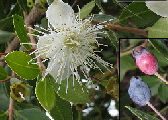 | |
| MaltaWildPlants.com by Stephen Mifsud |

|
| |
|
|
 |  |  |  |
| External Links: |
|
Dittrichia viscosa (False Yellowhead) |
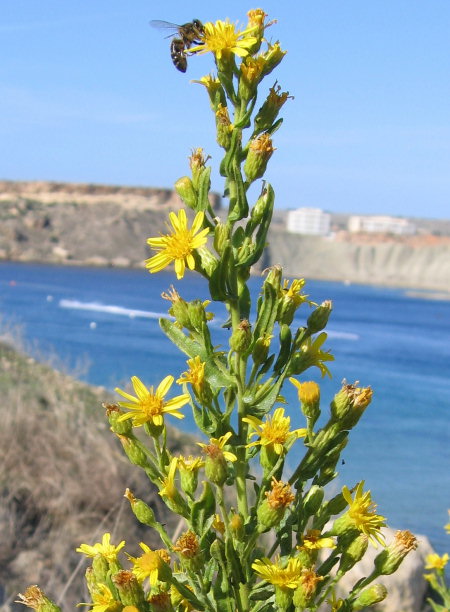
Dittrichia viscosa (ASTERACEAE.)
Images for this profile are taken from the Maltese Islands after year 2000. |
|
| Nomenclature |
Species name : | Dittrichia viscosa (L.) Greuter | Authority : | Carl von Linne, Sweden, (1707 - 1778) ;
Werner Rodolfo Greuter, Germany, (1938 - ) | Synonyms :
(basionym or principal syn.) |
|
Plant Family : | Asteraceae Bercht. & J.Presl (= Compositae )
(Daisy or Sunflower Family) | English name(s) : | False Yellowhead, Sticky Fleabane, Aromatic Inula | Maltese name(s) : | Tulliera komuni | Status for Malta : | Indigenous. Present on the Maltese islands before man | Name Derivation : |
Dittrichia: Genus dedicated to Manfred Dittrich (1934-), a botanist from Germany. He was a specialist in Asteraceae at the Herbarium of the Geneva, Switzerland, Conservatory and Botanical Garden and later Director of the Herbarium of the Botanic Garden and Botanical Museum Berlin-Dahlem. ( ); 2 = Genus dedicated to Manfred Dittrich (1934-), botanist from Germany. He was a specialist in Asteraceae at the Herbarium of the Geneva, Switzerland, Conservatory and Botanical Garden and later Director of the Herbarium of the Botanic Garden and Botanical Museum Berlin-Dahlem (Latin);.
viscosa: having a sticky and viscous coating or texture. (Latin origin ); 2 = Sticky, referring mainly to the sticky exudate from the glandular hairs (Latin).
| Remarks : | |
|
| Morphology and structure |
PLANT STRUCTURE: |
Character | Growth Form | Branching | Surface |
Description | | | |
General
Picture |  | 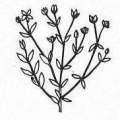 | 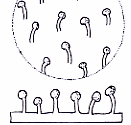 |
|
LEAVES: |
Character | Arrangement | Attachment | Venation |
Description | | | |
General
Picture |  |  |  |
| |
Character | Leaf Shape | Leaf Margin | Remarks |
Description | | | |
General
Picture |  | 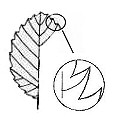 |  |
|
FLOWERS: |
Character | Colour | Basic Flower Type | No. of Petals | No. of Sepals |
Description | Bright Yellow | | 12-18 Number varies depending flower size. | 30-40 Referring to the phyllaries of the involucre. |
General
Picture | | 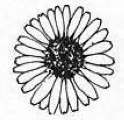 |  |  |
| |
Character | Inflorescence | Description | Ovary | Stamens |
Description | | Each flower head is held in a green, cylindrical to semi-spherical involucre and consists of about 14 yellow, strap-like spreading, non-overlapping petals (ray florets) with numerous (about 36) disc florets at the centre. The ligules are long (10-12mm) and exceed well the involucre. | | |
General
Picture |  |  | 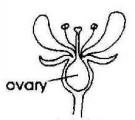 | 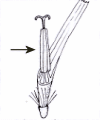 |
| |
Character | Scent | Average Flower Size | Pollen Colour | Other Notes |
Description | YES Slightly sweet, aromatic nice smell. | 20-22mm | Yellow | - |
|
SEEDS: |
Character | No. Per Fruit | Shape | Size | Colour |
Description | 40-50 This is the number of seeds per flower head because to be precise the true fruit is the single seeded achene developped from a floret. | | 2mm | Light brown (Pappus is beige coloured). |
General
Picture |  |  |  |  |
|
FRUIT AND OTHER BOTANICAL DATA: |
Character | Fruit Type | Colour of Fruit | Subterranean Parts | Other Notes |
Description | | Brown / Beige | | Scent Most of the plant parts (esp leaves) have a an aromatic scent. |
General
Picture | 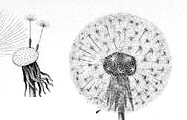 |  |  |  |
|
|
| Plant description and characters | |
Life Cycle: | Perennial. |
Growth Form: | CHAMEOPHYTE (dwarf or small woody shrubs) |
Habitat: | Disturbed land, steppe, abandoned fields, coastal areas |
Frequency: | Common |
Localities in Malta: | Very Common everywhere throughout the Maltese Islands. |
Plant Height: | 40-140cm. |
| Sep-Nov |
Protection in Malta: | Not legally protected till the last update of this website (2/Mar/2022) |
Red List 1989: | Not listed in the Red Data Book of the Maltese Islands |
Poison: | |
This plant usually forms several branches at the basal/medial part and each branch forms numerous leaves and dense panicles of yellow flowers. Mature large plants can take the form of a small shrub. The basal stem becomes woody, dark brown and thick.
The leaves have an elongated lanceolate shape with a pointed tip. The larger leaves measure about 70mm x 18mm. New shoots grow from the axils of the sessile leaves. With time these leaves become short stalked and eventually will fall off when the shoot is well developed. Two interesting features of the leaves are the serrated outline and the sticky glandular hair. The margin of mature leaves has sparse, large (2mm) teeth-like projections that are not spiny or hard. Also all leaves are covered with glandular hairs that release a sticky resin-smelling substance, which can be felt when underside of leaves is rubbed. For this reason this plant is sometimes called sticky fleabane.
The plant is very conspicuous during the flowering time of late September and October thanks to the several hundreds of flowers (measuring around 20mm across) that it produce in dense panicles. Each flower is a capitulum consisting of a light green involucre made up by 4 to 5 rows of phyllaries holding a group of about 40-60 tiny ray and disk florets sitting on a common flat receptacle. There are about 12-16 bright yellow ray florets (ligules) which radiates out separately with little or no overlap. The central disk florets have a style+anther column that protrudes out from the floret corolla by 4mm. Flowers have a slightly sweet to aromatic smell.
Each flowerhead produces a fruit that resembles a straw-coloured ball of soft bristles. This is composed of a group of seeds (achenes) which have a bristly pappus at the top. When the fruit is ripe, the phyllaries, which during the flowering stage they where erect and packed together, will spread out flat so as the achenes are exposed to be easily dispersed by wind. Each seed is 2mm long, light brown in colour and its unbeaked pappus is made up of about 15 unbranched rigid bristles (5mm long). By estimation a medium sized plant may produce an average of 600-700 flowers per year each giving rise to about 50 viable seeds.
|
|
| Information, uses and other details |
Nativity and distribution
Northern Africa: Algeria; Egypt; Libya; Morocco; Tunisia
Western Asia: Cyprus; Israel; Jordan; Lebanon; Syria; Turkey
Europe: Albania; Bulgaria; Greece (incl. Crete); Italy (incl. Sardinia, Sicily); Yugoslavia
Southwestern Europe: France (incl. Corsica); Portugal; Spain (incl. Baleares and Canary islands)
[ WWW-26]
False yellowhead is native to southern Europe (including France, Spain, Greece, Italy and Bulgaria) through to Turkey and the Middle East (Israel, Jordan and Syria). It is also found in northern Africa (Algeria, Egypt and Libya). [WWW-117]
Mediterranean. Introduced and naturalized in a few localities in Britain [17] .
Dittrichia graveolens (Inula graveolens) - a related species in Malta
Inula graveolens was noticed to grow alongside Inula viscosa in many sites, but its presence was more often encountered in waste and fallow grounds then in less disturbed places. This annual plants closely resembles Inula viscosa, in fact sometimes it was impossible to choose between the two.
As the summer days verged towards the Autumn months less and less of the plant was seen in those places which in the sunnier days were invaded by it. The green colour of the leaves became paler and dry stems devoid of leaves were seen with increasing frequency.
[WWW-115]
Cultivation and Propagation Details
Grows freely in a sunny position in ordinary garden soil [1] .
Seed - we have no details on this species but suggest sowing it in spring in a greenhouse and only just covering the seed. When they are large enough to handle, prick the seedlings out into individual pots and grow them on in the greenhouse for at least their first winter. Plant them out into their permanent positions in late spring or early summer, after the last expected frosts. [KF]
Germination generally takes place following rainfall and can be quite prolific when fire or mechanical disturbance create bare ground. Under laboratory conditions, false yellowhead seeds have been shown to undergo a deep dormancy, which is broken by a lack of light. Seeds of the closely related stinkwort Dittrichia graveolens are viable for about three years. [WWW-117]
False yellowhead usually prefers, but is not restricted to, high rainfall areas. It can be found on both clay and sandy soils. [WWW-117]
The plant was found growing with higher frequency in red coloured soils i.e. Terra soil; the leaves were broader and the plant reached greater heights.
This type of soil is found mostly in the south, south-eastern, northern and western parts of the country. In fact the plant was found to grow best in these regions, though further studies are necessary in order to establish whether it is the soil which influences this or if it due also to other factors.
In the mediterranean region goethite (FeO-OH) is responsible for most of the coloration. Its colours range from reddish-brown to yellow as it hydration increases.
The organic matter content tends to become darker in colour with increasing humidification and in the presence of large amounts of calcium (as in Malta) and sodium. This may contribute to the dark colour. [WWW-115]
Dispersion and Spreading
False yellowhead spreads by seed. Seed dispersal is aided by the 'pappus', an arrangement of bristles at the end of the seed, which catches the wind or can assist flotation. Seed can also be spread during soil movement (eg in road making or road grading) or when attached to machinery. [WWW-117]
Invasive Weed Problem
False yellowhead is a prolific seed producer and a threat in the higher rainfall regions of southern Australia. It is known to release substances that inhibit the germination of nearby plants, and to be toxic to stock. It can also cause contact dermatitis in people.
False yellowhead produces large numbers of seeds and is spreading rapidly along roadsides and walking trails in southwestern Western Australia.
It favours disturbed habitat, particularly after fires. Preventing the further spread of false yellowhead is cheaper and easier than all other control options. [WWW-117]
Case study: The invasion of false yellowhead into the urban parks of Albany, Australia
False yellowhead was first recorded in Albany, a coastal city of 30,000 people located 400 km southeast of Perth in Western Australia, in 1955. It probably escaped from a garden and has now spread throughout the region. It is becoming increasingly common along roadsides and walking trails, and occasionally in relatively undisturbed bushland.
The City of Albany is responsible for managing the city's parks and reserves and provides specialist weed management and revegetation assistance to community groups. This includes equipment such as weeding tools and a trailer, as well as free access to either of the city's waste disposal sites to dispose of weeds. The city's Environmental Weed Strategy lists eleven priority sites, the highest ranked being the Mt Adelaide and Mt Clarence Reserve, which is situated near the coast and the city centre. The City of Albany and the 'Friends of Mt Adelaide and Mt Clarence' community group have undertaken an ongoing weed management program in the reserve, which includes another Alert List for Environmental Weeds species, holly leaved senecio, Senecio glastifolius.
Consequently, when outbreaks of false yellowhead were noticed in the reserve, a joint project between the City of Albany and the 'Friends' was initiated to attempt to rid the reserve of false yellowhead, even though it is not one of the top 15 priority weeds in the region. The outbreak was apparently related to an earlier bushfire as this species readily invades areas after disturbance.
Spraying roadside infestations of false yellowhead has been undertaken over the past two years, using a vehicle-mounted sprayer and hose, reel and electric pump. Results have been encouraging, with good kill rates helped by the clumping of plants, although it has been important to spray before seed set.
The 'Friends' have worked in conjunction with City staff, and have undertaken follow-up manual weeding of any false yellowhead plants they have encountered. It is a particularly difficult species to hand pull, even in moist soil. Instead, they use a fork to remove plants, minimising disturbance to the soil and reducing the likelihood of germination of weed seeds. All plant material is bagged and dumped at the local tip because seeds can still form on flowering plants left on the ground after removal.
Occasionally, the cut-stump method has been used to treat larger plants. This involves cutting the plant at the base and quickly applying herbicide to the stump.
In other roadside areas some control has been achieved by regular mowing of false yellowhead before flowering and seeding. However, protective clothing must be worn because mowing can release the irritating oils that are stored in the leaves.
Results of the project so far have been encouraging, although an ongoing commitment will be required to minimise potential impacts in the future from this environmental weed. All those involved in the project are concerned about how rapidly false yellowhead is spreading along roads and tracks and throughout disturbed bushland in the region. [WWW-117]
Medicinal Uses
The plant has the following medicinal properties according to reference: [WWW-66] .
| Malaria |
Helps to treat Malaria [SM] |
| Tumour |
Helps to treat tumours [SM] |
Other Uses
A yellow dye is obtained from the roots [46, 61] .
Traditional medicine uses of Inula viscosa (Dittrichia viscosa)
Below is a list of writings from very ancient books which describes how Dittrichia viscosa (also known as Inula viscosa) was used for medicinal purposes in the past. Most of them where translated from Hebrew. [WWW-116] The reference source of each writing is given before.
Ref: Medicinal Plants of North Africa
Author; Loufty Boulus, Published by Reference Publications, USA, (1983). Library of Congress Catalog Card Number: 82-20412. International Standard Book Number: 0-917256-16-6
"Inula viscosa (L.) Ait. Uses: Flowering branches used for bronchitis, tuberculosis, anemia,
astringent, fattening, for malaria and diseases of the urinary system, boiled in oil, the oil is rubbed on bruises and swelling, cataplasm for rheumatic pains; powdered and mixed with henna leafs, a cataplasm is used forsunstroke, (Algiers Drug Market)." [WWW-116]
Ref: The Medicinal Plants of the Holy Land
Authors; Prof. Dan Palevitz and Dr. Zoahara Yaniv. The Israeli Agricultural Research Administration.
Published in Hebrew by Tamuz Mudan, Israel, (1991), Pg.157:
"Folk Medicine: Inula viscosa is a plant of many uses, it is recommended to use Inula leaves for
treatment of scurvy, a tonic prepared from the leaves is used to treat hangover after heavy drinking, Inula viscosa leaf powder is used for arthritis treatment. In Algiers, Inula viscosa branches are boiled in oil, the oil is used for topical treatment of swelling, arthritis and sun stroke, Arabs in the holy land regards Inula viscosa as one of the most important medicinal plants, one that heals 40 different ailments." [WWW-116]
Ref: A Bag of Plants The Medicinal and Useful Plants of Israel".
Author; Nissim Krispil. Yara Publishing House, published in Hebrew, Jerusalem, Israel. (1987).
Descriptions of Inula viscosa in traditional medicine uses were compiled from ancient scriptures and from first hand interviews with Arab and Bedouin villagers in Israel and Palestinian territories who practice traditional folk medicine until this time
P 351; The writer Pilinius (c. AD 23-79). Roman scientific encyclopedist and historian wrote; "the Inula plant strengthens the teeth, when prepared it is used against cough, boiled juice of its roots evict worms, dried and crushed to powder it is used against cough and a medicine for stomach cramps and against stomach gases, it is useful for healing of poisonous animals bites".
P 351; The researcher B. Tzisik calls Inula viscosa "Rara". Llocal Arabs in several locations in Israel call the plant "Rara ayub" the name means the plant that helped the biblical Prophet Job (Ayub in Arabic) endure his torture and pain, he finds further references in the Bible, in the book of proverbs, (king Solomon's proverbs), Inula viscosa remedy is mentioned as: "wounds and browses and abdomen chambers ailments should be treated with Ra".
P 352; "At the Arab village Abud in Samaria (Palestinian Authority), I was told by the locals that they use powder of dry Inula viscosa leaves or a water extract as a topical treatment for open and bleeding wounds, they said that application of the water extract has a efficacy similar to that of Iodine."
P 355; As already said, uses on Inula viscosa in traditional medicine practiced by the Arabs in Israel, A. Hareuveni, the researcher of flora of the land of Israel wrote in his studies: " there are places where Inula leafs are dried, than powdered and spread over the wound, there are those who say that the leafs have to be dried inside the house for several days, other people say that fresh leaves can be placed on the wound, all the Arabs I spoke to hailed the healing activity of the plant. In several villages in the vicinity of Jerusalem the plant is used to reduce swollen body parts".
P 355; B. Tzisik writes in his studies; "In the traditional medicine of the Arabs Inula viscosa is highly respected, they use it for treatment of arthritis and paralysis."
P 356, 357; "Wound treatment with Inula viscosa tincture; Inula viscosa leaves tincture in alcohol is
considered a proven medicine for treatment and prevention of infections that can form in open wounds, the tincture is produced by squeezing a large amount of leafs, in this context, some of the peasants immerse the leaves in alcohol and use it as medicinal iodine is used on open and bleeding wounds, for wounds that happened in the field, fresh leafs are attached to the wound, this help blood clotting and prevents infection."
P 357; "Inula viscosa infusion for blood pressure and diabetes reduction; Inula viscosa is considered by the Arab peasants as one of the five best herbs for treatment of diabetes and blood pressure reduction, fresh leafs are picked, the dosage is 3 to 5 leaves per cup of tea, this makes a yellow infusion, side effects of drinking this infusion is enhanced urination and running stomach"
P 358; "Bathing in leafs infusion as a treatment for arthritis and joints pain; 200 gram of Inula viscosa leaves is boiled for five minutes in a Litter of water, the infusion is filtered and added to half full bath tub of warm water, the patient stays in the bath for 30 minutes, the treatment is good for treatment of arthritis and joints pain."
P 358; "Treatment for swollen or bleeding gums: 10 gram of Inula viscosa leaves is boiled in half a liter of water for 5 minutes until a yellow infusion is reached, a mouth full of the infusion is repeated several times as needed."
P 358; " A paste for treatment for Hemorrhoids: Fresh Inula viscosa leaves are picked, dried and crushed, the powder is mixed in olive oil and applied to the affected part." [WWW-116]
Ref: Rabbi Moshe Ben Mimon (Mimonides) Medicinal Plants" Author; Nissim krispil. published in Hebrew, Yarid Sfarim, (1989), pg.125
"It contains many useful medications for the body, for the liver and its efficacy is clear and explainable", in his writings, Moshe Ben Mimon, mentions the writings of the Arab physician Al Tamimi
of Jerusalem, who lived in the tenth century, (died in 985 ad.), and practiced medicine at the Fatimi Halifs palace, and so he wrote: " The Raesen (Inula viscosa) prepared in honey and perfumes and consumed as a drink, is called "the tonic of kings", it is useful for the elderly, it treats wet nose, (running nose), it is useful for joints treatment, enhances the hart and stomach, and arises the sexual lust and desire for intercourse." [WWW-116]
"It is used in traditional medicine as a treatment for joints pain, back pain and swollen feet, Inula leaf tincture is considered a proven medicine for treatment of infections in open wounds."
[WWW-116]
Ref: The Mandragora gave smell" Folklore Chapters of the Plants of Israel. Author; Amotz Dafni. Publication of the Applied Research Company, Haifa University, Israel, (1991), pg 35:
"Villagers in Samaria use the powder made of dry Inula viscosa leaves for wound healing, and are those who apply fresh leaves directly on wounds, the Arab villagers of the land use Inula for a steam
bath treatment of rheumatism." [WWW-116]
Toxicity
False yellowhead, like D. graveolens, can cause health problems in humans and animals. The oil on the leaves and stems causes contact dermatitis, resulting in itching and blistering skin. Stock that eat the flower heads of D. graveolens can develop enteritis (inflammation of the small intestine) because the pappus irritates and punctures the lining of the small intestine, eventually leading to pulpy kidney disease and sudden death if untreated. It is thought that D. viscosa would have similar impacts on grazing animals [WWW-117]
Antimicrobial activity of the essential oils of Dittrichia viscosa subsp. viscosa on Helicobacter pylori
Dittrichia viscosa subsp. viscosa is found on edges, wood clearings and in waste places of the Iberian Peninsula. Aerial parts of D. viscosa were collected at flowering phase in September-October 2001 around Lisbon, Portugal and the essential oils isolated by hydro-distillation for 4 h using a Clevenger-type apparatus. The oils were analyzed by gas chromatography and gas chromatography-mass spectrometry. Preliminary examination of the essential oils allowed the identification of 32 components. Only four components reached percent-ages over 5%: fokienol (11.8%), T-muurorol (7.9%), (E)-nerolidol (5.5%) and -cadinene (5.0%). The essential oils were tested against Helicobacter pylori and Listeria monocytogenes. Essen-tial oils did not have antimicrobial activity against L. monocytogenes. The essential oil at 0.88 to 22.22 µg/ml did not inhibit the growth of H. pylori, affected the growth slightly at 44.40 µg/ml and completely inhibited the growth at 88.80 to 133.20 µg/ml. Results show that use of D. viscosa essential oil in the treatment of gastric disturbances.
[345]
The Pharmacognosy of the local plant Inula viscosa (by Stephen Spiter)
Abroad a large number of plants are constantly being screened for their possible pharmacological value.
Malta too withholds a variety of medicinal plants. One of these is Inula viscosa, (Maltese:Tulliera komuni, English:Sticky Fleabane), also known as Dittrichia viscosa or Cupularia viscosa. This medium, densely glandular, slender perennial with erect stems and a smell of camphor belongs to the Compositae family. It grows on stony hill slopes, damp habitats, waste and fallow ground and even on roadsides. In folk medicine it is used as diuretic, topical antipruritic, it is boiled in oil for myalgia, and it is used as haemostatic on surface wounds.
Scientific studies that have been carried out abroad revealed some interesting pharmacological effects of the plant, these include:
� Gastroprotection and prostaglandin E2 generation in rats by flavonoid extracts
� The effects of Isolated Hispidulin on guinea pig smooth muscles
� Research on the role of the plant in the treatment of diabetes
The results of these studies were published as articles on journals. Most of these articles were collected and the scientific information on them was organized in a digestible and cohesive way. {read full article here...} [WWW-115]
Constituents
Known plant constituents are:
Terpene derivatives,
Azulenes,
Hispidulin,
Psi-Taraxasterol acetate
Camphor,
Thymol,
Carvacrol,
Eucalyptol. [WWW-115]
Inhibitory effects of water soluble leaf leachates from Dittrichia viscosa on lettuce root growth, statocyte development and graviperception
The leaf epicuticular exudate of the Mediterranean ruderal Dittrichia viscosa is water soluble and easily drained to the soil by rain. As a result, soil enriched with this material is inhibitory for seed germination of lettuce, while germination of Malcolmia maritima, (a species co-occurring with D. viscosa in the same habitat) is considerably delayed. We investigated the possible mode of action of this material as a growth inhibitor by using germinating lettuce seeds in filter paper bioassays. Apart from a negative effect on final percentage of seed germination, the material reduced root length and the frequency of cell divisions in the meristematic zone, induced abundant lateral roots and completely suppressed the formation of root hairs. Moreover, the presence of statocytes was rare and their internal polarity strongly perturbed. As a result, the ability of primary roots to respond to gravity was suppressed. We suggest that the strong biological activity of the rinsate may enhance the competitive ability of D. viscosa by interfering with resource acquisition of germinating neighbors. [346]
Antifungal activity of essential oils from leaves and flowers of Inula viscosa (Asteraceae) by Apulian region.
Some essential oils from several plants (Artemisia verlotorum, Lavandula augustifolia, Ocimum gratissimum) have proved to have acaricidal, antifungal and antibacterial activity. Inula viscosa Ait. (Asteraceae), a plant growing spontaneously in the Mediterranean area, is currently used by popular medicine for its therapeutic effects. Flavonoids, azulenes, sesquiterpenes, and essential oils have been isolated and identified from its leaves. This paper reports the results of the composition and antifungal activity in vitro against dermatophytes and Candida spp. of the four essential oils obtained by steam distillation of the leaves, flowers, whole plant and whole plants without flower extracts of I. viscosa. All the extracts proved to have a significant antifungal activity against dermatophytes even at low concentrations (0.01 mg/ml). The leaf extracts exhibited the greatest antifungal efficacy. The high concentration of the sesquiterpene (carboxyeudesmadiene), occurring in the leaf extracts, may explain its greater antifungal activity. [347]
Effects of Inula viscosa leaf extracts on abortion and implantation in rats.
The anti-implantation and mid-term abortifacient effects exhibited by administration of Inula viscosa leaf extracts, were studied in rats. The aqueous extract administered i.p. on day 1-6 of gestation, totally diminished fetal implantation and caused a significant (P < 0.05) reduction in the number of corpora lutea and blood progesterone levels. Meanwhile, administration on day 13-15 of gestation exhibited mid-term abortion. Furthermore, petroleum ether and dichloromethane, but not methanol, extracts exhibited pronounced abortifacient effects. The results of this study are in agreement with the traditional reputation of this plant as abortifacient. Further, the plant possesses anti-implantational and luteolytic effects. [348]
Effect of Inula viscosa extract on chitin synthesis in dermatophytes and Candida albicans.
An antimycotic effect of an extract from Inula viscosa leaves was demonstrated affecting chitin synthesis in dermatophytes and Candida albicans. The antimycotic effect was compared to the effect caused by miconazole nitrate--an antifungal drug. The inhibition effect on chitin synthesis was not correlated to the extent of growth inhibition caused by the antifungal agents: both miconazole nitrate and the I. viscosa extract inhibited the growth of dermatophytes and C. albicans. Miconazole nitrate did not affect chitin synthesis--except for M. canis--whereas I. viscosa extract caused a significant decline in chitin content. [349]
Observations and research on an extract of Inula viscosa
The folk medical tradition ascribes to Inula viscosa (a suffrutescent plant of Compositae widely spread along the Mediterranean basin) balsamic, antipyretic, antiphlogistic and antiseptic properties. Pharmacological test on rabbits, made hyperpyretic in laboratory, gave satisfactory antipyretic results. Gas chromatographical separation from a high-boiling fraction of seven azulenes, two of them identified as 1,4-dimethyl-azulene (about 50% and chamazulene (32%), confirmed the antiphlogistic action ascribed to the plant. By the present research (solvent extraction, thin layer chromatography and gas chromatography are described in detail) eucalyptol was identified in a fraction of essential oil obtained from fresh leaves of the plant. This datum supports the balsamic and antiseptic properties of Inula viscosa. [350]
Gastroprotection and prostaglandin E2 generation in rats by flavonoids of Dittrichia viscosa.
Investigations were carried out to determine the gastroprotective effects of the flavonoid fraction of Dittrichia viscosa (L.) W. Greuter against gastric lesions produced by necrotizing agents. The action of the fraction on the production of mucus, and the involvement of endogenous PGs in gastric mucosal defensive mechanisms were also determined. Gastric ulcers induced by oral administration of three necrotic agents (100% ethanol, 0.6 N HCl, 30% NaCl) were markedly reduced by pretreatment with the flavonoid extract at doses from 125 to 500 mg/kg p.o. and the reduction at the highest dose (500 mg/kg p.o.) was practically complete. Flavonoid fraction pretreatment also increased mucus production and glycoprotein content. In addition, intraperitoneal administration of indomethacin (10 mg/kg i.p.) to animals treated with the extract (500 mg/kg) partially inhibited gastric protection but the PGE2 determination did not show an increase in prostanoid level. These observations suggest that the gastroprotective effects of the flavonoid fraction from D. viscosa could be partly explained through non-prostaglandin-dependent mechanisms. [351]
Allergic contact dermatitis from Dittrichia viscosa (L.) Greuter.
9 cases of contact sensitivity to Dittrichia viscosa, mainly with an airborne pattern, are described. All patients reacted to the fresh leaf of the plant and to its ethereal extracts at 1 and 0.5% pet., and some of them also to that at 0.1% pet. Positive reactions to Frullania dilatata, Laurus nobilis, some other members of the Compositae, and helenin were observed, suggesting the diagnosis of a sesquiterpene-lactone-induced allergic contact dermatitis. [352]
Personal Observations
Successful weed plant even in disturbed land
I have encountered this plant in many different places and habitats around Malta - from fields, roadsides, cliffs/garigues to disturbed land and cracks in wall stones. It is the most common yellow-flowering plant in Malta during September and beg October before the crucifers (Eg Diplotaxis tenuifolia and Brassica Rapa) takes over later in October and November.
In Malta, this plant is one of the most successful to grow and spread rapidly in disturbed grounds, where in many cases it just grew from limestone ruble and stones (See example photo). Each plant produces millions of viable seeds which are carried away to considerable distances by wind. Hence , it is a potential invasive weed in Malta and it should be controlled in order to safeguard other delicate flora which are already threatened by the decreasing land and man activities. [SM] To worsen things more, there are reports [WWW-117] which state that D. viscosa prohibits surrounding plants to germinate. [SM]
Pollination
Maybe due to lack of competing flowers in Autumn, but this plant attracts numerous bees, wasps and sometimes butterflies to feed on. This flowering plant is very conspicuous because in October it would be nearly covered with bright yellow flowers (see example) since it produces dense panicles. [SM]
Medicinal Plant
Several reports suggest that this plant possesses many medicinal virtues and it would be a good idea if the Maltese Governement invests to research this common plant and propagate it for medicinal extracts. [SM]
Differences between D. viscosa and D. graveolens
The following table gives a list of features which distinguishes the two related plants from each other [SM]
| Feature |
Dittrichia viscosa |
Dittrichia graveolens |
| Flower Size |
20-22mm diameter - ligules distinctly exceeding the involucre |
10-14mm diameter - ligules scarcely exceeding involucre |
| Woody basal stem |
Often |
Seldom |
| Leaf shape and size |
Elongated lance shaped - 70mm x 18mm (mature leaf) |
Narrower, rather oblong - 70mm x 12mm (mature leaf) |
| Height |
Can reach over 120cm |
Rather small plant, 20-50cm high |
| Pappus |
15 bristles |
30 bristles - looking more 'dense' |
| Smell of overall plant |
Sweet aromatic smell |
Often described as stinking (camphor smell) |
| Habit |
Perennial |
Annual |
|
|
| Links & Further literature
(0 papers) |

Google Web |

Google Images |

Google Scholar |

Research Gate |

Wikipedia |

JSTOR |

GBIF |

Med Checklist |

Cat. of Life |

EoL |

IPNI |

World Flora Online |

Plants of the World Online |

Vienna Virt. Herb. |

RBGE Herbarium |

KEW Herbarium |

MNHN |

Arkive |

IUCN |

CABI |
Kindly Email if there are papers and publications about local
studies or information about this species to be included in the list above.
|
| Photo Gallery (37 Images) |  |
 |
 |
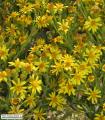 |
IMAGE: DTRVS-01 Photo of plant and its cluster of numerous yellow flowers. |
IMAGE: DTRVS-02 Photo of plant with large numbers of flowers making it very conspicuous in September and October. |
IMAGE: DTRVS-03 Photo of many flowers in a dense inflorescence of the plant. |
IMAGE: DTRVS-04 Another photo of the numerous daisy-like yellow flowers with a darker center. |
 |
 |
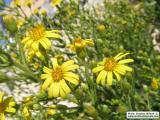 |
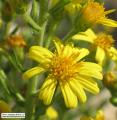 |
IMAGE: DTRVS-05 Photo of flower panicle taken at Gnejna (Malta) in mid October. |
IMAGE: DTRVS-06 Photo of few flowers showing some of their detail. They have about 12-16 radiating petals (ray florets) and darker centre of rayless disc florets. |
IMAGE: DTRVS-07 Photo of three flowers in situ. The upper one is the youngest with erect stamens/style column. Flowers measure about 20-22mm across. |
IMAGE: DTRVS-08 Close up photo of flower showing finer detail of the central disk florets with long protruding stamens/style columns. There are about 30-40 disk florets per flowerhead. |
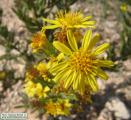 |
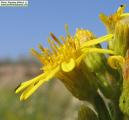 |
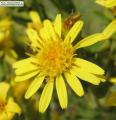 |
 |
IMAGE: DTRVS-09 Another close up photo of flower. The petals have 3 longitudinal bands and a flat edged tip with 3 tiny teeth. |
IMAGE: DTRVS-10 Photo of the lateral view of flower to show the style protruding out from each floret by about 4-5mm. Around the style there are 5 united stamens (seen as brown bands) and a 2-parted stigma at the apex. |
IMAGE: DTRVS-11 Close up photo of flower showing detail of the florets and petals. |
IMAGE: DTRVS-12 Photo of the inflorescence of the plant which is a dense panicle of daisy-like yellow flowers. |
 |
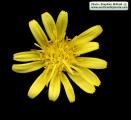 |
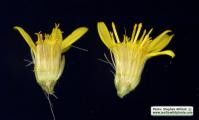 |
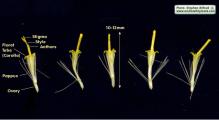 |
IMAGE: DTRVS-13 Photo of a typical flower panicle found at the upper part of every branch. |
IMAGE: DTRVS-14 Scanned image of flower. Petal number varies between 11-16. Florets have a star shaped corolla. |
IMAGE: DTRVS-15 Scanned image of a longitudinally dissected flowerhead, showing several florets with an inferior ovary (whitish-green colour) sitting on a common flat receptacle. |
IMAGE: DTRVS-16 Scanned, magnified and annotated image of some disc florets of the plant. |
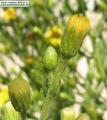 |
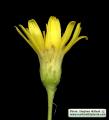 |
 |
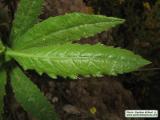 |
IMAGE: DTRVS-17 Close up photo of the cylindrical involucre which is made up of 4 to 5 rows of green phyllaries (also known as involucral bracts. Phyllaries of upper rows are more elongated than the lower ones. |
IMAGE: DTRVS-18 Scanned image of the involucre. |
IMAGE: DTRVS-19 Photo of leaves in situ. They are large compared to a similar species (D. graveolens) where mature leaves measure about 70mm x 18mm. |
IMAGE: DTRVS-20 Photo of typical leaf having an elongated lanceolate shape with serrated margins. Some teeth are large but never sharp. They have a pointed apex and a quite dark coloration. |
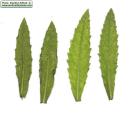 |
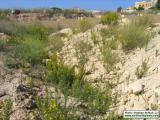 |
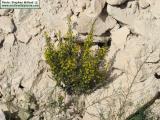 |
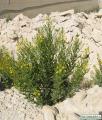 |
IMAGE: DTRVS-21 Scanned image of 4 mature leaves. Some describe the margin as dentate, but since the teeth are at an acute angle with the leaf margin (not perpendicular), it should be described as serrated. |
IMAGE: DTRVS-22 Photo of one of the many habitats of the plant. This is stony (globigerina limestone) disturbed land, where many plants fail to grow. Wasteland is another common habitat. |
IMAGE: DTRVS-23 Photo of plant growing through limestone dump. |
IMAGE: DTRVS-24 Photo of a typical plant. It consists of several leafy branches (branching from lower part) topped with dense panicle of yellow flowers. |
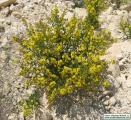 |
 |
 |
 |
IMAGE: DTRVS-25 Photo of plant showing its potential of forming hundreds of flowers. No wonder why it attracts many pollinating insects such as bees, wasps and some butterflies. |
IMAGE: DTRVS-26 Photo of plant which often have dried, brown leaves at the base to the medial part of the branching stems. Basal stems often woody. |
IMAGE: DTRVS-27 Photo of plant in a rocky habitat (Oct 2005). |
IMAGE: DTRVS-28 Photo of plant at coastal areas (Oct 2005). Plant can grow quite large (shrub form). |
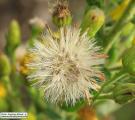 |
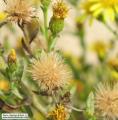 |
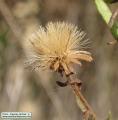 |
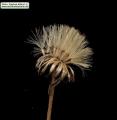 |
IMAGE: DTRVS-29 Photo of fruit which looks like a ball of straw-coloured soft bristles. |
IMAGE: DTRVS-30 Photo of fruit which consists of a group of achenes with a bristly pappus. Its purpose is to carry and disperse the achene (seed) by wind. |
IMAGE: DTRVS-31 Another close up photo of the fruit. Note that the phyllaries, which during the flowering stage they where erect forming a cylindrical involucre, now assume a prostrate shape to expose better the achenes. |
IMAGE: DTRVS-32 Scanned image of fruit showing some individual seeds. |
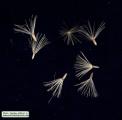 |
 |
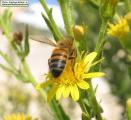 |
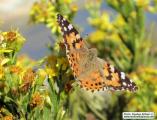 |
IMAGE: DTRVS-33 Scanned image of seeds. The achene is 2mm and the pappus is 4-5mm long and made up of about 15 rigid bristles. |
IMAGE: DTRVS-34 Photo of flowers being visited by bees. The large number of yellow flowers in months where other flowers are not much available in the wild makes this plant a strong attractor to pollinators. Additionally, the plant is advantaged by having a sweet aromatic smell. |
IMAGE: DTRVS-35 Close up photo of a bee feeding on the nectar of a false yellowhead flower. |
IMAGE: DTRVS-36 Photo of a butterfly (called painted lady - Cynthia cardui) also attracted by the false yellowhead. |
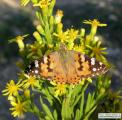 |
| | | IMAGE: DTRVS-37 Close up photo of C. cardui - astonishing patterns/colours. |
IMAGE: DTRVS-38 |
IMAGE: DTRVS-39 |
IMAGE: DTRVS-40 |
|
| | |

